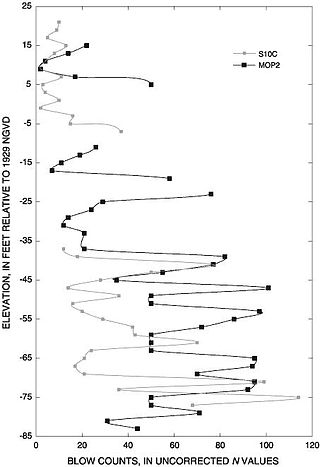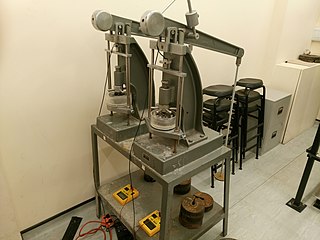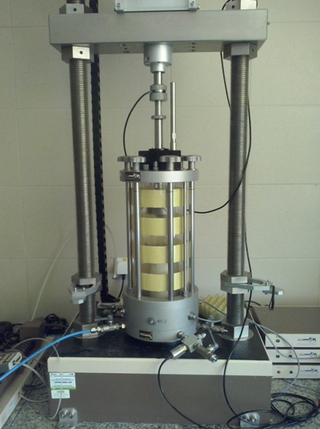
Geotechnical engineering is the branch of civil engineering concerned with the engineering behavior of earth materials. It uses the principles of soil mechanics and rock mechanics for the solution of its respective engineering problems. It also relies on knowledge of geology, hydrology, geophysics, and other related sciences. Geotechnical (rock) engineering is a subdiscipline of geological engineering.

In engineering, a foundation is the element of a structure which connects it to the ground, transferring loads from the structure to the ground. Foundations are generally considered either shallow or deep. Foundation engineering is the application of soil mechanics and rock mechanics in the design of foundation elements of structures.

Soil mechanics is a branch of soil physics and applied mechanics that describes the behavior of soils. It differs from fluid mechanics and solid mechanics in the sense that soils consist of a heterogeneous mixture of fluids and particles but soil may also contain organic solids and other matter. Along with rock mechanics, soil mechanics provides the theoretical basis for analysis in geotechnical engineering, a subdiscipline of civil engineering, and engineering geology, a subdiscipline of geology. Soil mechanics is used to analyze the deformations of and flow of fluids within natural and man-made structures that are supported on or made of soil, or structures that are buried in soils. Example applications are building and bridge foundations, retaining walls, dams, and buried pipeline systems. Principles of soil mechanics are also used in related disciplines such as geophysical engineering, coastal engineering, agricultural engineering, hydrology and soil physics.

Karl von Terzaghi was an Austrian mechanical engineer, geotechnical engineer, and geologist known as the "father of soil mechanics and geotechnical engineering".
The Atterberg limits are a basic measure of the critical water contents of a fine-grained soil: its shrinkage limit, plastic limit, and liquid limit.

The standard penetration test (SPT) is an in-situ dynamic penetration test designed to provide information on the geotechnical engineering properties of soil. This test is the most frequently used subsurface exploration drilling test performed worldwide. The test procedure is described in ISO 22476-3, ASTM D1586 and Australian Standards AS 1289.6.3.1. The test provides samples for identification purposes and provides a measure of penetration resistance which can be used for geotechnical design purposes. Many local and widely published international correlations which relate blow count, or N-value, to the engineering properties of soils are available for geotechnical engineering purposes.
Pore water pressure refers to the pressure of groundwater held within a soil or rock, in gaps between particles (pores). Pore water pressures below the phreatic level of the groundwater are measured with piezometers. The vertical pore water pressure distribution in aquifers can generally be assumed to be close to hydrostatic.
A direct shear test is a laboratory or field test used by geotechnical engineers to measure the shear strength properties of soil or rock material, or of discontinuities in soil or rock masses.

In geotechnical engineering, soil compaction is the process in which stress applied to a soil causes densification as air is displaced from the pores between the soil grains. When stress is applied that causes densification due to water being displaced from between the soil grains, then consolidation, not compaction, has occurred. Normally, compaction is the result of heavy machinery compressing the soil, but it can also occur due to the passage of, for example, animal feet.

Soil consolidation refers to the mechanical process by which soil changes volume gradually in response to a change in pressure. This happens because soil is a two-phase material, comprising soil grains and pore fluid, usually groundwater. When soil saturated with water is subjected to an increase in pressure, the high volumetric stiffness of water compared to the soil matrix means that the water initially absorbs all the change in pressure without changing volume, creating excess pore water pressure. As water diffuses away from regions of high pressure due to seepage, the soil matrix gradually takes up the pressure change and shrinks in volume. The theoretical framework of consolidation is therefore closely related to the concept of effective stress, and hydraulic conductivity. The early theoretical modern models were proposed one century ago, according to two different approaches, by Karl Terzaghi and Paul Fillunger. The Terzaghi’s model is currently the most utilized in engineering practice and is based on the diffusion equation.

Geotechnical investigations are performed by geotechnical engineers or engineering geologists to obtain information on the physical properties of soil earthworks and foundations for proposed structures and for repair of distress to earthworks and structures caused by subsurface conditions; this type of investigation is called a site investigation. Geotechnical investigations are also used to measure the thermal resistance of soils or backfill materials required for underground transmission lines, oil and gas pipelines, radioactive waste disposal, and solar thermal storage facilities. A geotechnical investigation will include surface exploration and subsurface exploration of a site. Sometimes, geophysical methods are used to obtain data about sites. Subsurface exploration usually involves soil sampling and laboratory tests of the soil samples retrieved.

A triaxial shear test is a common method to measure the mechanical properties of many deformable solids, especially soil and rock, and other granular materials or powders. There are several variations on the test.
The Proctor compaction test is a laboratory method of experimentally determining the optimal moisture content at which a given soil type will become most dense and achieve its maximum dry density. The test is named in honor of Ralph Roscoe Proctor, who in 1933 showed that the dry density of a soil for a given compactive effort depends on the amount of water the soil contains during soil compaction. His original test is most commonly referred to as the standard Proctor compaction test; his test was later updated to create the modified Proctor compaction test.

Shear strength is a term used in soil mechanics to describe the magnitude of the shear stress that a soil can sustain. The shear resistance of soil is a result of friction and interlocking of particles, and possibly cementation or bonding of particle contacts. Due to interlocking, particulate material may expand or contract in volume as it is subject to shear strains. If soil expands its volume, the density of particles will decrease and the strength will decrease; in this case, the peak strength would be followed by a reduction of shear stress. The stress-strain relationship levels off when the material stops expanding or contracting, and when interparticle bonds are broken. The theoretical state at which the shear stress and density remain constant while the shear strain increases may be called the critical state, steady state, or residual strength.
Arthur Casagrande was an American civil engineer born in Austria-Hungary who made important contributions to the fields of engineering geology and geotechnical engineering during its infancy. Renowned for his ingenious designs of soil testing apparatus and fundamental research on seepage and soil liquefaction, he is also credited for developing the soil mechanics teaching programme at Harvard University during the early 1930s that has since been modelled in many universities around the world.
Rankine's theory , developed in 1857 by William John Macquorn Rankine, is a stress field solution that predicts active and passive earth pressure. It assumes that the soil is cohesionless, the wall is frictionless, the soil-wall interface is vertical, the failure surface on which the soil moves is planar, and the resultant force is angled parallel to the backfill surface. The equations for active and passive lateral earth pressure coefficients are given below. Note that φ' is the angle of shearing resistance of the soil and the backfill is inclined at angle β to the horizontal.

Cellular confinement systems (CCS)—also known as geocells—are widely used in construction for erosion control, soil stabilization on flat ground and steep slopes, channel protection, and structural reinforcement for load support and earth retention. Typical cellular confinement systems are geosynthetics made with ultrasonically welded high-density polyethylene (HDPE) strips or novel polymeric alloy (NPA)—and expanded on-site to form a honeycomb-like structure—and filled with sand, soil, rock, gravel or concrete.
Preconsolidation pressure is the maximum effective vertical overburden stress that a particular soil sample has sustained in the past. This quantity is important in geotechnical engineering, particularly for finding the expected settlement of foundations and embankments. Alternative names for the preconsolidation pressure are preconsolidation stress, pre-compression stress, pre-compaction stress, and preload stress. A soil is called overconsolidated if the current effective stress acting on the soil is less than the historical maximum.
Geoprofessions is a term coined by the Geoprofessional Business Association to connote various technical disciplines that involve engineering, earth and environmental services applied to below-ground (“subsurface”), ground-surface, and ground-surface-connected conditions, structures, or formations. The principal disciplines include, as major categories:
Gholamreza Mesri is a geotechnical engineering researcher, professor, and consultant. He currently lectures at the University of Illinois at Urbana–Champaign.
















